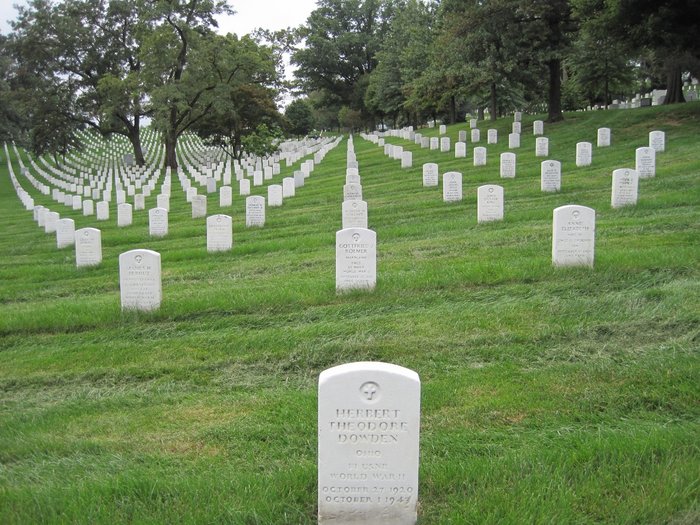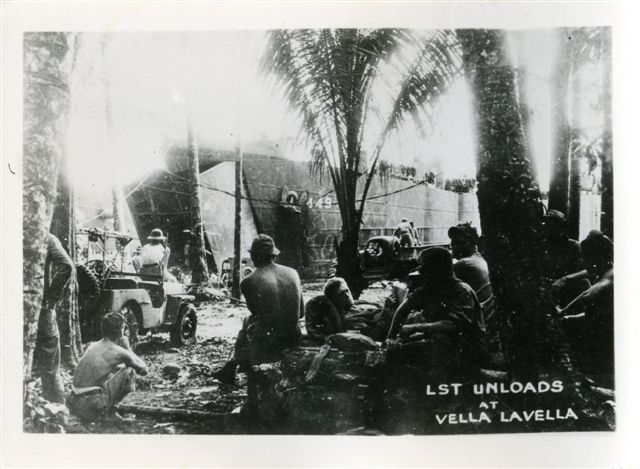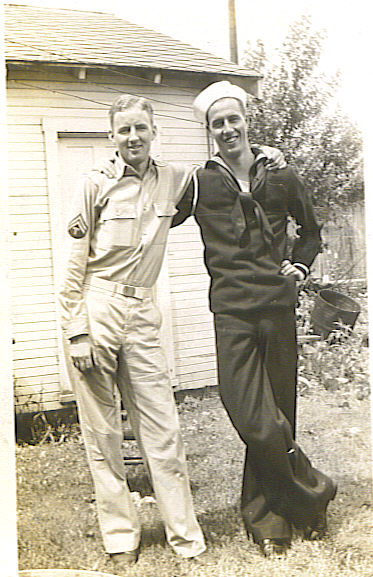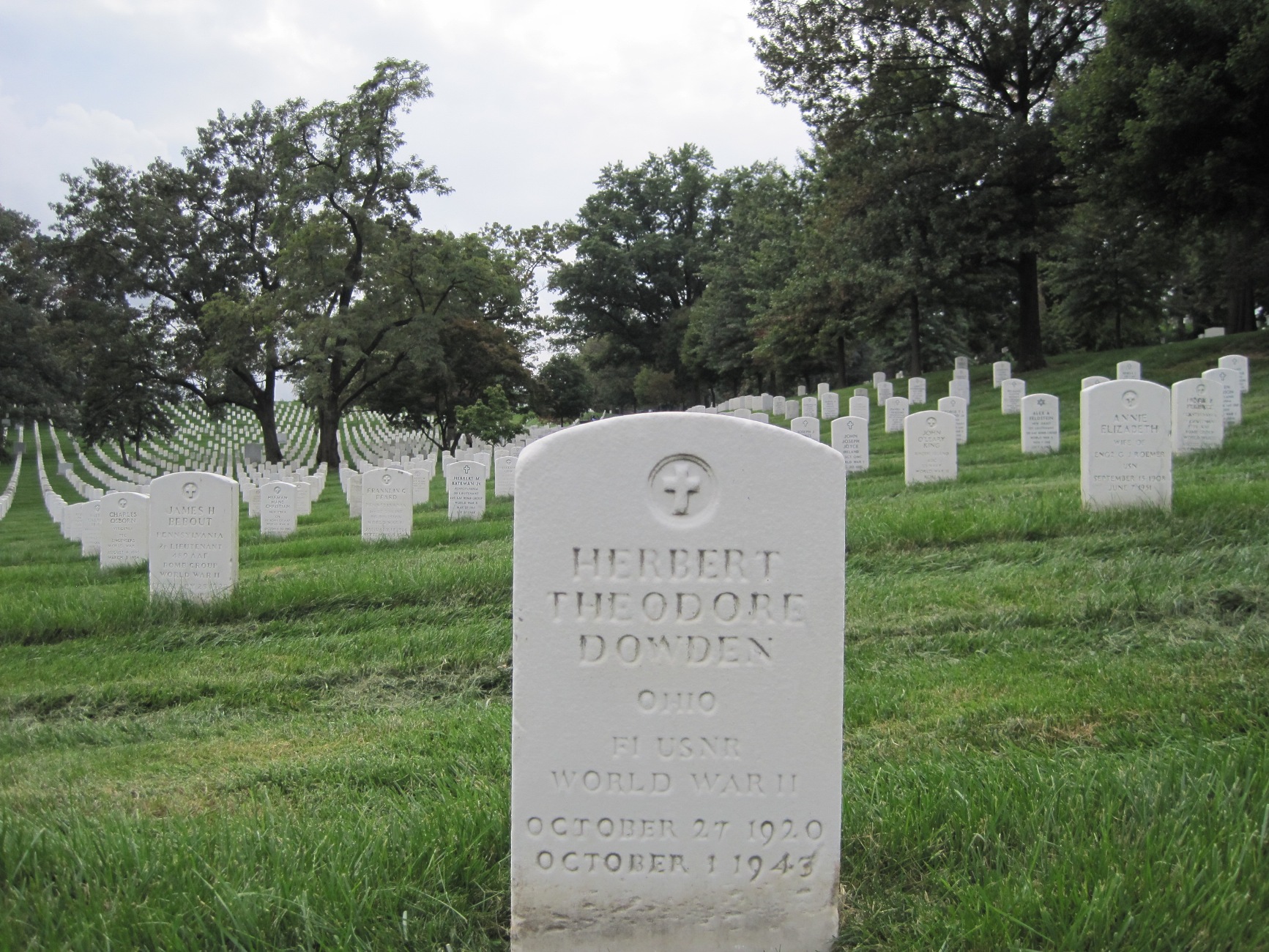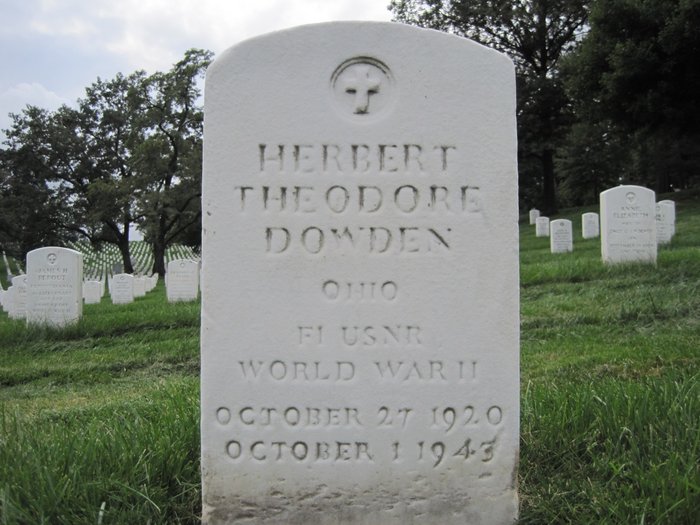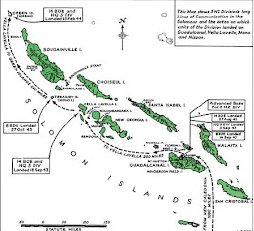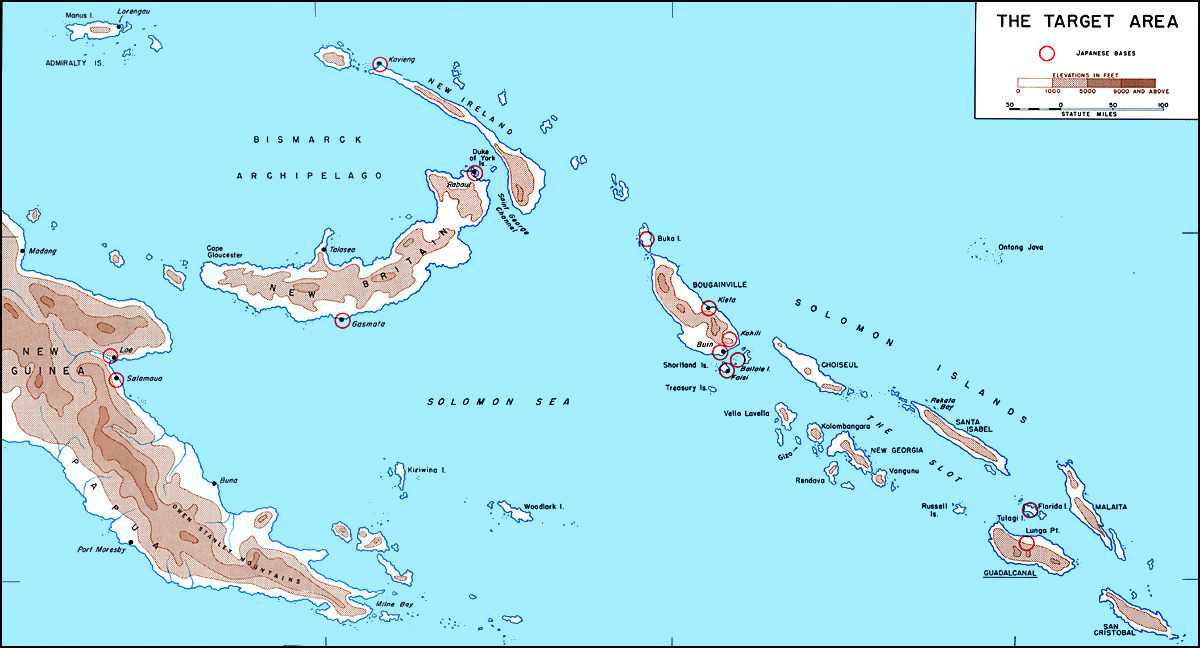Herb served as a Fire Controlman First Class on the U.S.S. LST 448, U.S. Navy and was killed in action at Niarovai Bay, Vella Lavella Island, in the Solomon Islands. He enlisted from Ohio on February 4, 1942 with service number 6142308.
Mr. T. V. Dowden of Mt. Liberty has received the following letter of sympathy from Lt. (jg) Harold F. Breimyer, USNR, an officer on the ship in which Herbert Dowden lost his life during an engagement in the Southwest Pacific area last October:
"Mr. T. V. Dowden
Mt. Liberty, Ohio.
Dear Mr. Dowden:
In some respects I should not write you a letter reminding you of the death of your son, but because I doubt that you have gone far toward forgetting, I am doing so in order to give you a little recent information.
I was an officer on your son's ship, having been with him since the day the crew was formed in the Solomons, Maryland. Although there is no bond like that of ones family, an officer in the Navy develops a strong personal feeling when he has worked with a man for a long time, watching him develop from a "boot" to a man capable of carrying out his duties on board a ship on his own responsibility. As your son's officer I too mourn his death.
Because of the length of time that has elapsed, I can now give you a little more information than could Captain Roeschke. Our ship was hit by aerial bombs while we were beached, unloading cargo. It was at a forward area, and we were at our battle stations. Your son was on a gun on main deck. The hit was nearly directly on the gun, the entire crew of which was wiped out. I think that death came quickly, probably without any realization of the hit.
Through the enterprise of a New Zealand Army Unit, a monument to the men lost on our ship has been erected at the site of the beaching. I saw it some time ago, finding it to be an appropriate type stone, about four feet high and pyramidal in form. I received permission to attach a plaque commemorating and naming the men of the ship's crew who died. The plaque has now been completed and forwarded. It was my thought that you would appreciate knowing of the memorial. I cannot tell you yet the name of the island where our ship was lost. I am saving all addresses, planning a further letter of information after the war. Should you (undecipherable) address .. Portland, Indiana. Meanwhile if I can answer any questions I will be glad to receive them.
I possibly should add that I have not had a chance to visit the burial ground. Interment was made by a unit of U. S. Marines, and as yet I have no information other than that the bodies recovered were buried in a U. S. Navy Cemetery on the island. At present I can't give much confidence on this point.
I can do little more than offer you my sincere sympathy. Those of us who were also in the engagement often wonder why it was we who were saved, unhurt in my case, while others were killed. It is beyond my power to give an answer.
Captain Roeschke and nearly all the enlisted men have now returned to the United States for leave and new assignments, with the rest of the men due to return soon. The officers will stay out here for a while longer.
Yours very sincerely,
LT. (jg) USNR"
____________________
Condensed from the Wartime Interlude chapter in the book Over-Fulfilled Expectations: A Life and an Era in Rural America (Agricultural History & Rural Studies) by Harold F. Breimyer
According to historical data, we believe,
Herbert left Portland, Oregon on New Year's Eve 1942 on newly built U.S.S. LST 448* (Landing Ship-Tank) a 330 foot, 50 foot beam ship with seven officers and 108 crewmen. At a max speed of 10 knots it stopped at San Diego, San Francisco and Pearl Harbor then to Noumea, New Caledonia. Next to the Solomon Islands where all went well for several months until it moved forward to Niarovai Bay, Vella Lavella Island and began to disgorge provisions on the beach for the troops. At precisely twelve noon several Japanese Zero bombers attacked killing more than 50 including Herbert and 18 of his crew mates. Rumor spread, but never verified that the Japanese timed their raid since they knew that the air cover would quit early for lunch, although refueling might have caused the gap in protection. Then another version timed the attack at 9:30 a.m. out of the sun.
The following description of the aftermath of the raid was found in Invasion of Vella Lavella, excerpt provided by Robert D. Soule, Seaman First Class, attached to Advance Naval Base 338: On October 1 , 1943 I was assigned to a working party to unload an LST. While unloading it, we came under a bombing attack from the Japs. A plane coming for our LST was shot down and crashed in the jungle. The LST 448 which was two LSTs from ours, got hit by a bomb from another plane. The next day two other men and myself went back to LST 448 to see if we could salvage anything for our base. Top side there were still men at their guns and dead. We went below and saw that the elevator had fallen down from the explosion and there were dead men lying around it, most of them were burn't.
An account of the incident as depicted in The Gunners: an intimate record of units of the 3rd New Zealand Divisional Artillery in the Pacific from 1940 until 1945 Chapter V — On Vella Lavella
During the last few days of September enemy air activity was increasing and on 1 October the main body of the 209th Battery arrived from Guadalcanal in a large convoy which proved irresistible bait to the Japanese. Despite the curtain of fire put up by the guns on the ships and ashore, the Japs made persitent attacks on the landing craft when a bomb landed directly on another LST, killing Sergeant M. J. Healy, of M troop, his whole detachment and several Americans. Several others were wounded, the gun and much equipment destroyed the ship was set on fire by the explosion. in the resulting confusion Battery Sergeant-Major W. D. Campbell and Gunner W. G. Donnelly—to mention only two—played a gallant part in getting wounded personnel off the ship and salvaging equipment. Later in the day another gun crew had a miraculous escape when a bomb crashed through the deck alongside them and failed to explode. Some 207th Battery guns on the beach had a busy day also and 'B 2' gun claimed a probable kill, although it could not be credited to them for certain as no wreckage could be discovered. The 209th got ashore without further incident and the victims of the raid were buried on the following day. A monument was later erected to their memory by members of the battery and it was unveiled on 28 November at Nairovai by Major G. H. Turner in the presence of Major-General Barrow-Clough, who praised the good work done by both batteries in the Vella Lavella engagement.
*The Seabees began dispersing into the jungle, where they would dig their foxholes. LST 448, beached a half mile north of Echelon One, was still unloading. Marines had charge of the operation and it was not proceeding as quickly as it should have. Echelon One sent a work detail to assist discharging LST 448. At 09:30, a large force of Japanese fighters and dive-bombers raided the staging area. One veteran recalled how he was walking on the beach to retrieve his rifle and gear and saw a ‘V' formation of about sixteen aircraft come out of the sun. He first thought they were allied planes, but the sudden cry "air raid" and the formation's nosing over into a dive convinced him otherwise. The Seabees and Marines ran for the cover of the jungle as the anti-aircraft guns on ship and shore sputtered to life. Some men fired their rifles at the incoming planes. Two Japanese dive-bombers swept down and released their payloads on LST 448. The men watched helplessly as the bombs fell into the beached ship. Their was a muffled explosion and the Sixth men could feel the ground tremble from the force of the blast though the exploding ship was half a mile away. Seconds after the impact of the bombs, the Sixth men took to their feet running down the beach toward LST 448. When Japanese fighters swept in and strafed the beach the 20 or so running Seabees dived into the jungle for cover, re-emerging to continue their dash as the enemy fighters passed. The Japanese planes bombed the dispersal areas too, wounding many among the work parties and gun crews. LST 448 was a twisted burning wreck when the Seabees got to her. Ammunition was exploding in her hold and magazines. Marines were helping the wounded, assisted by the Sixth's medical officer who stayed on board throughout the afternoon despite the fires, exploding ordinance and a second attack. Many men were wounded. Of the work detail the Sixth had dispatched before the raid, eight men were wounded by shrapnel, two seriously, and another could not be found at all. Though he was listed as missing in action, it was clear two days later, when 21 unidentified bodies were pulled out of the wreckage, that Echelon One had lost one of its own. U. S. S. LST 448 was laid down on 10 July 1942 at Vancouver, Wash., by Kaiser, Inc.; launched on 26 September 1942; and commissioned on 23 December 1942.
Under enemy fire- 6th Special Seabees, Second Section's Echelon One at Vella La Vella - October 1, 1943 - November 22, 1943
During World War II, LST-448 was assigned to the Asiatic-Pacific theater and participated in the consolidation of the southern Solomons in June 1943 and the Vella Lavella occupation in October 1943. The tank landing ship was damaged by Japanese dive bombers off Vella Lavella, Solomons, on 1 October, suffering some casualties among her embarked New Zealand troops.(plus 19 American heros) The LST was taken under tow by tug Bobolink but sank while underway on 5 October south of Vella Lavella. She was struck from the Navy list on 26 October 1943.
LST-448 earned two battle stars and the Navy Unit Commendation for World War II service.
25 October 2005 (Last paragraph taken from the U.S. Dept.of Navy - Naval Historical Center, Washington D.C. 20374)
~
Names of U. S. S. LST 448 crew members who lost their lives with Herbert on October 1, 1943 from the September 1943 Muster Roll
Joseph Preston Adams - Virginia
Mark M Burgess - Caddo Parish, Lousiania
George L Cazaubon, Jr - New Orleans
Johnny C Dickens - Burbank, California
Raymond Francis Fallon - New York State
William J Gray - Illinois
Harold D Hancock - Virginia
Alfred Willard Larue - West Virginia
Ben P Lawicki - Cleveland, Ohio
John J Martin - Illinois
John P Martin- Oregon
Harold E O'Neil - New York State
Joseph E Shanahan - Pennsylvania
William Wester - New Jersey
Frank E Whiterock - Colorado
Herbert T Dowden - Ohio
The following men were in the crew and died in 1943
Wilton G. Fox wounded on LST-448 and died in New Caledonia - Oneida County, New York
Jack Douglas Malloy - Utah
Link to first cousins who lost their lives in WW II - Donald Hurley and Elwood Slane
Herb served as a Fire Controlman First Class on the U.S.S. LST 448, U.S. Navy and was killed in action at Niarovai Bay, Vella Lavella Island, in the Solomon Islands. He enlisted from Ohio on February 4, 1942 with service number 6142308.
Mr. T. V. Dowden of Mt. Liberty has received the following letter of sympathy from Lt. (jg) Harold F. Breimyer, USNR, an officer on the ship in which Herbert Dowden lost his life during an engagement in the Southwest Pacific area last October:
"Mr. T. V. Dowden
Mt. Liberty, Ohio.
Dear Mr. Dowden:
In some respects I should not write you a letter reminding you of the death of your son, but because I doubt that you have gone far toward forgetting, I am doing so in order to give you a little recent information.
I was an officer on your son's ship, having been with him since the day the crew was formed in the Solomons, Maryland. Although there is no bond like that of ones family, an officer in the Navy develops a strong personal feeling when he has worked with a man for a long time, watching him develop from a "boot" to a man capable of carrying out his duties on board a ship on his own responsibility. As your son's officer I too mourn his death.
Because of the length of time that has elapsed, I can now give you a little more information than could Captain Roeschke. Our ship was hit by aerial bombs while we were beached, unloading cargo. It was at a forward area, and we were at our battle stations. Your son was on a gun on main deck. The hit was nearly directly on the gun, the entire crew of which was wiped out. I think that death came quickly, probably without any realization of the hit.
Through the enterprise of a New Zealand Army Unit, a monument to the men lost on our ship has been erected at the site of the beaching. I saw it some time ago, finding it to be an appropriate type stone, about four feet high and pyramidal in form. I received permission to attach a plaque commemorating and naming the men of the ship's crew who died. The plaque has now been completed and forwarded. It was my thought that you would appreciate knowing of the memorial. I cannot tell you yet the name of the island where our ship was lost. I am saving all addresses, planning a further letter of information after the war. Should you (undecipherable) address .. Portland, Indiana. Meanwhile if I can answer any questions I will be glad to receive them.
I possibly should add that I have not had a chance to visit the burial ground. Interment was made by a unit of U. S. Marines, and as yet I have no information other than that the bodies recovered were buried in a U. S. Navy Cemetery on the island. At present I can't give much confidence on this point.
I can do little more than offer you my sincere sympathy. Those of us who were also in the engagement often wonder why it was we who were saved, unhurt in my case, while others were killed. It is beyond my power to give an answer.
Captain Roeschke and nearly all the enlisted men have now returned to the United States for leave and new assignments, with the rest of the men due to return soon. The officers will stay out here for a while longer.
Yours very sincerely,
LT. (jg) USNR"
____________________
Condensed from the Wartime Interlude chapter in the book Over-Fulfilled Expectations: A Life and an Era in Rural America (Agricultural History & Rural Studies) by Harold F. Breimyer
According to historical data, we believe,
Herbert left Portland, Oregon on New Year's Eve 1942 on newly built U.S.S. LST 448* (Landing Ship-Tank) a 330 foot, 50 foot beam ship with seven officers and 108 crewmen. At a max speed of 10 knots it stopped at San Diego, San Francisco and Pearl Harbor then to Noumea, New Caledonia. Next to the Solomon Islands where all went well for several months until it moved forward to Niarovai Bay, Vella Lavella Island and began to disgorge provisions on the beach for the troops. At precisely twelve noon several Japanese Zero bombers attacked killing more than 50 including Herbert and 18 of his crew mates. Rumor spread, but never verified that the Japanese timed their raid since they knew that the air cover would quit early for lunch, although refueling might have caused the gap in protection. Then another version timed the attack at 9:30 a.m. out of the sun.
The following description of the aftermath of the raid was found in Invasion of Vella Lavella, excerpt provided by Robert D. Soule, Seaman First Class, attached to Advance Naval Base 338: On October 1 , 1943 I was assigned to a working party to unload an LST. While unloading it, we came under a bombing attack from the Japs. A plane coming for our LST was shot down and crashed in the jungle. The LST 448 which was two LSTs from ours, got hit by a bomb from another plane. The next day two other men and myself went back to LST 448 to see if we could salvage anything for our base. Top side there were still men at their guns and dead. We went below and saw that the elevator had fallen down from the explosion and there were dead men lying around it, most of them were burn't.
An account of the incident as depicted in The Gunners: an intimate record of units of the 3rd New Zealand Divisional Artillery in the Pacific from 1940 until 1945 Chapter V — On Vella Lavella
During the last few days of September enemy air activity was increasing and on 1 October the main body of the 209th Battery arrived from Guadalcanal in a large convoy which proved irresistible bait to the Japanese. Despite the curtain of fire put up by the guns on the ships and ashore, the Japs made persitent attacks on the landing craft when a bomb landed directly on another LST, killing Sergeant M. J. Healy, of M troop, his whole detachment and several Americans. Several others were wounded, the gun and much equipment destroyed the ship was set on fire by the explosion. in the resulting confusion Battery Sergeant-Major W. D. Campbell and Gunner W. G. Donnelly—to mention only two—played a gallant part in getting wounded personnel off the ship and salvaging equipment. Later in the day another gun crew had a miraculous escape when a bomb crashed through the deck alongside them and failed to explode. Some 207th Battery guns on the beach had a busy day also and 'B 2' gun claimed a probable kill, although it could not be credited to them for certain as no wreckage could be discovered. The 209th got ashore without further incident and the victims of the raid were buried on the following day. A monument was later erected to their memory by members of the battery and it was unveiled on 28 November at Nairovai by Major G. H. Turner in the presence of Major-General Barrow-Clough, who praised the good work done by both batteries in the Vella Lavella engagement.
*The Seabees began dispersing into the jungle, where they would dig their foxholes. LST 448, beached a half mile north of Echelon One, was still unloading. Marines had charge of the operation and it was not proceeding as quickly as it should have. Echelon One sent a work detail to assist discharging LST 448. At 09:30, a large force of Japanese fighters and dive-bombers raided the staging area. One veteran recalled how he was walking on the beach to retrieve his rifle and gear and saw a ‘V' formation of about sixteen aircraft come out of the sun. He first thought they were allied planes, but the sudden cry "air raid" and the formation's nosing over into a dive convinced him otherwise. The Seabees and Marines ran for the cover of the jungle as the anti-aircraft guns on ship and shore sputtered to life. Some men fired their rifles at the incoming planes. Two Japanese dive-bombers swept down and released their payloads on LST 448. The men watched helplessly as the bombs fell into the beached ship. Their was a muffled explosion and the Sixth men could feel the ground tremble from the force of the blast though the exploding ship was half a mile away. Seconds after the impact of the bombs, the Sixth men took to their feet running down the beach toward LST 448. When Japanese fighters swept in and strafed the beach the 20 or so running Seabees dived into the jungle for cover, re-emerging to continue their dash as the enemy fighters passed. The Japanese planes bombed the dispersal areas too, wounding many among the work parties and gun crews. LST 448 was a twisted burning wreck when the Seabees got to her. Ammunition was exploding in her hold and magazines. Marines were helping the wounded, assisted by the Sixth's medical officer who stayed on board throughout the afternoon despite the fires, exploding ordinance and a second attack. Many men were wounded. Of the work detail the Sixth had dispatched before the raid, eight men were wounded by shrapnel, two seriously, and another could not be found at all. Though he was listed as missing in action, it was clear two days later, when 21 unidentified bodies were pulled out of the wreckage, that Echelon One had lost one of its own. U. S. S. LST 448 was laid down on 10 July 1942 at Vancouver, Wash., by Kaiser, Inc.; launched on 26 September 1942; and commissioned on 23 December 1942.
Under enemy fire- 6th Special Seabees, Second Section's Echelon One at Vella La Vella - October 1, 1943 - November 22, 1943
During World War II, LST-448 was assigned to the Asiatic-Pacific theater and participated in the consolidation of the southern Solomons in June 1943 and the Vella Lavella occupation in October 1943. The tank landing ship was damaged by Japanese dive bombers off Vella Lavella, Solomons, on 1 October, suffering some casualties among her embarked New Zealand troops.(plus 19 American heros) The LST was taken under tow by tug Bobolink but sank while underway on 5 October south of Vella Lavella. She was struck from the Navy list on 26 October 1943.
LST-448 earned two battle stars and the Navy Unit Commendation for World War II service.
25 October 2005 (Last paragraph taken from the U.S. Dept.of Navy - Naval Historical Center, Washington D.C. 20374)
~
Names of U. S. S. LST 448 crew members who lost their lives with Herbert on October 1, 1943 from the September 1943 Muster Roll
Joseph Preston Adams - Virginia
Mark M Burgess - Caddo Parish, Lousiania
George L Cazaubon, Jr - New Orleans
Johnny C Dickens - Burbank, California
Raymond Francis Fallon - New York State
William J Gray - Illinois
Harold D Hancock - Virginia
Alfred Willard Larue - West Virginia
Ben P Lawicki - Cleveland, Ohio
John J Martin - Illinois
John P Martin- Oregon
Harold E O'Neil - New York State
Joseph E Shanahan - Pennsylvania
William Wester - New Jersey
Frank E Whiterock - Colorado
Herbert T Dowden - Ohio
The following men were in the crew and died in 1943
Wilton G. Fox wounded on LST-448 and died in New Caledonia - Oneida County, New York
Jack Douglas Malloy - Utah
Link to first cousins who lost their lives in WW II - Donald Hurley and Elwood Slane
Inscription
OHIO
F1C USNR
WORLD WAR II









